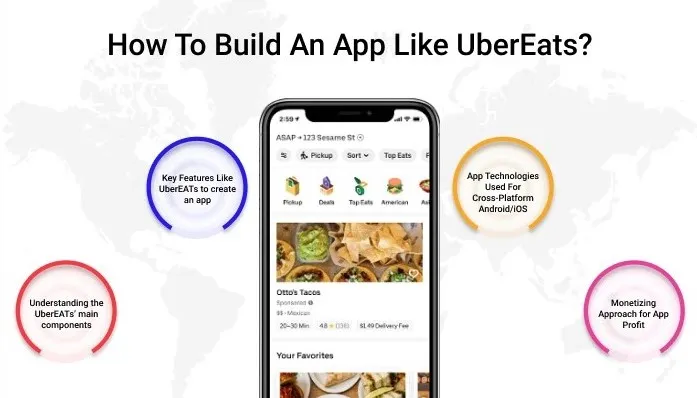The Rise of On-Demand Food Delivery Services
The food service sector has experienced explosive growth in recent years, driven by growing demand for effortless on-demand services. With platforms like Uber Eats and DoorDash transforming the way people request meals, the emphasis has shifted to developing innovative food delivery apps. These apps provide customers the ability to place orders from their favorite restaurants and have it brought right to their location. For businesses, the task is to leverage technology to improve delivery operations and ensure a smooth customer experience.
Building the Perfect Food Delivery App
Creating a successful food delivery app requires a deep insight of the market trends and operational strategies that dominate the sector. Whether creating a full-stack delivery solution or concentrating on niche areas like virtual restaurants or cloud kitchens, the app’s functionality must to cater to both users and restaurants. Essential elements such as order tracking, efficiency improvement, and customer satisfaction indicators play a vital role in ensuring customer loyalty.
Restaurant Delivery Partnerships: A Winning Strategy
Eateries are increasingly establishing partnerships with delivery platforms to increase their customer reach. These agreements help restaurants provide to a larger customer base while minimizing the obstacles of running their in-house delivery operations. The success of such alliances depends on technological synchronization, which enhances the app usability and improves the user satisfaction. Through these collaborations, restaurants can increase customer loyalty and make sure that they remain relevant in a crowded market.
How KPIs Drive Food Delivery Profitability
For any business, understanding its performance metrics is essential to maintaining financial health. In the food delivery industry, KPIs such as time efficiency, order accuracy, and customer satisfaction are critical. Measuring and improving these KPIs enables delivery services to provide a superior customer experience. Moreover, keeping an eye on financial success helps companies optimize operations, reduce charges, and improve overall efficiency.
Customer Satisfaction and User Retention Strategies
A significant factor in the success of delivery apps is their ability to keep customers through outstanding customer service. Providing quick service and addressing customer reviews swiftly can help companies enhance their service offerings. In addition, implementing rewards systems and providing incentives like free delivery can enhance customer loyalty. Customer satisfaction can be further strengthened by maintaining food quality control and providing a seamless processing system.
The Role of Technology in Food Delivery
Technology is at the heart of modern food delivery services, helping companies refine their operations and provide a smooth customer experience. From app creation to real-time delivery tracking systems, tech integration plays a significant role in the growth of delivery platforms. The application of data analytics to understand customer demographics and preferences allows delivery services to provide personalized experiences, further enhancing customer interaction.
Competitive Analysis in the Food Delivery Market
The food delivery market is highly competitive, with numerous players competing for market share. Food Quality Control Measures Conducting a competitive analysis allows companies to assess their position in the market and identify chances for growth. Delivery platforms must stand out by providing distinctive features such as virtual restaurant options, quick service, or niche cuisine options. Understanding sector dominance and consumer behavior empowers companies to tailor their services and remain ahead of the rivals.
The Impact of the Pandemic on Food Delivery Services
The COVID-19 pandemic has had a substantial impact on the delivery services, boosting its growth as more people turned to on-demand apps due to social distancing measures. The shift has emphasized the necessity of technological evolution in the food industry, with restaurants quickly adopting online food ordering and delivery apps. As the world adjusts to new normals, delivery services must continue innovating to meet changing consumer demands and secure business growth.
Investing in Food Delivery Startups
The food delivery industry presents numerous startup opportunities, with investors keen on support companies that provide unique solutions. From developing UberEats clones to developing niche delivery apps, business owners have a range of paths to pursue. Investors look for strong business models and the ability to scale, particularly in areas like delivery network optimization, user experience Customer Satisfaction in Delivery (UX), and tech integration. By focusing on these sectors, startups can secure substantial investments and gain a foothold in the market.
Enhancing Food Delivery Service Profitability and Expansion
Expanding a food delivery business demands a strong base built on market penetration, cost models, and service differentiation. As local delivery services grow, businesses must focus on creating a reliable delivery network and maintaining quality standards. In addition, expanding the menu options, forming new collaborations, and adopting advanced tech solutions in food delivery will propel further expansion. By constantly optimizing delivery times and ensuring high customer satisfaction, companies can maintain a competitive edge and increase revenue generation.
These themes offer a complete understanding of the service landscape, with a focus on key aspects that drive the industry forward. Whether you’re a new company or an experienced business, concentrating on these areas will help you succeed in the challenging world of food delivery.
